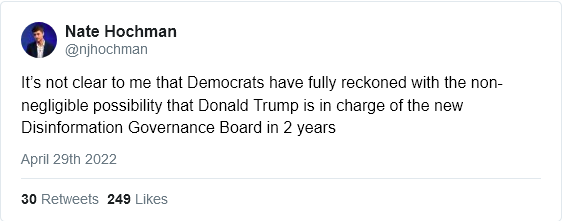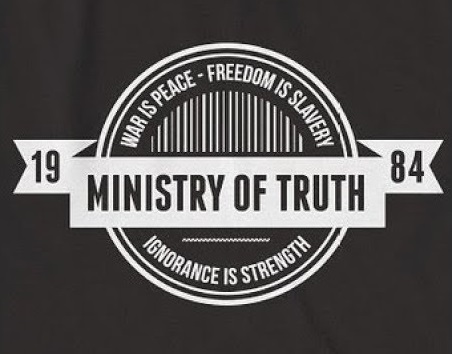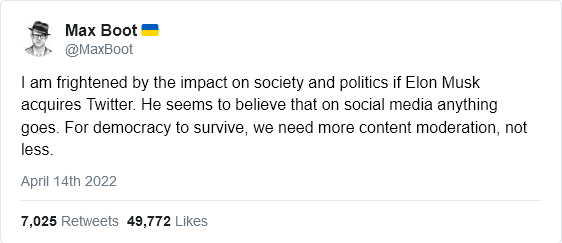I’ve come to the conclusion that at least 1 in 5 people on social media are the reason silica gel packets need to have “Do Not Eat” on them.
Amanda (Pandamoanimum) on Twitter, 2015-09-13.
May 21, 2022
QotD: People on social media
May 19, 2022
Alas, poor MiniTru … sent off to the knacker’s yard so soon
Apparently the Biden administration is reconsidering the decision to set up a “Ministry of Truth” — at least for the time being — and as Chris Bray shows, the media wants to talk about the evil, Nazi trolls who brought it down:
Labeling instead of describing; a narrative frame instead of factual discussion. Be grateful for Taylor Lorenz, because her cartoon journalism makes the game so gloriously obvious.
Cartoon Lady sort of “reports”, this morning, on the apparent demise of another cultural cartoon: Nina Jankowicz is on her way out at DHS, which is probably disbanding the Disinformation Governance Board. Here, via Revolver, is a non-paywalled copy of the story:
The story is an assemblage of right-out-of-the-gate assumptions, all relentlessly untested. Jankowicz is a “victim”, all disagreement with the decision to start the Disinformation Governance Board was part of a campaign of “coordinated online attacks”, the work of the board was good, disagreement with its creation was bad. None of that is established or explained — it merely is. Here’s the Big Frame, the here’s-what-it-all-means:
Jankowicz’s experience is a prime example of how the right-wing Internet apparatus operates, where far-right influencers attempt to identify a target, present a narrative and then repeat mischaracterizations across social media and websites with the aim of discrediting and attacking anyone who seeks to challenge them. It also shows what happens when institutions, when confronted with these attacks, don’t respond effectively.
The federal government created a new organization, and people discussed its existence. Criticism and questions necessarily centered on, wait for it, the person identified as the executive director of the new board, the only person publicly identified as a staff member at the organization. The far-right monsters used the tactic of attempting to “identify a target” by … talking about the person chosen, and publicly identified by government, as the leader and public face of a government operation. See how cleverly the extremists choose their targets!?!?!? I mean, who else would you talk about if you wanted to discuss the Disinformation Governance Board? She ran it.
Then, known demon Jack Posobiec tweeted stuff, the monster, and his “early tweets shaped the narrative and Jankowicz was positioned as the primary target.” Again, the person positioned as the primary target of criticism of a government board was the director of the board — after the building burned down, cruel extremists maliciously singled out the fire chief as their target — but Cartoon Lady presents it as a dark and ominous maneuver:
Just hours after Jankowicz tweeted about her new job, far-right influencer Jack Posobiec posted a tweets accusing the Biden administration of creating a “Ministry of Truth”. Posobiec’s 1.7 million followers quickly sprung into action. By the end of the day, there were at least 53,235 posts on Twitter mentioning “Disinformation Governance Board”, many referencing Jankowicz by name, according to a report by Advance Democracy, a nonpartisan, nonprofit organization that conducts public-interest research. In the days following, that number skyrocketed.
My goodness, people referenced her by name! They referenced the executive director of the board while discussing the creation of the board! nOw dO YoU SeE HOw thE DaRK ArTs oF thE NaZI tRolLs WoRk!?!?!?
May 8, 2022
“… a majority of ‘pro-lifers’ are women, not men. So [Kamala] Harris is effectively saying: how dare women be allowed a voice in this debate?”
Andrew Sullivan comments on the leak of a draft US Supreme Court decision that would strike down Roe vs. Wade and the over-the-top reactions on social media from progressives:

Panorama of the west facade of United States Supreme Court Building at dusk in Washington, D.C., 10 October, 2011.
Photo by Joe Ravi via Wikimedia Commons.
To say that a leaked draft of a Supreme Court ruling prompted an elite meltdown would be a gross understatement. This was a culture war 9/11. “I have typed and deleted a great many comments,” Roxane Gay tweeted. “What do you say when nine people can dictate what happens to your body? It’s ridiculous and hateful.” The Atlantic‘s Adam Serwer, always the subtle one, announced that the court had abolished the entire 20th century. Yep: no more suffrage for women! Jim Crow now!
Taking the arguments of abortion opponents seriously was never an option: “Stripping women of their humanity and rights isn’t a consequence of the ‘pro-life’ agenda, it’s the entire point,” declared Jessica Valenti. Rebecca Traister confessed: “My teeth have been chattering uncontrollably for an hour. Bodies/minds are so weird. Like, not euphemistically — actually chattering. Audibly. And full shaking body. Though otherwise wholly, rationally, well and truly expecting it.”
Going further, freshly-minted critical gender theorist, Jennifer Rubin, argued that any restriction on abortion rights is a violation of secularism: “The right-wing justices and their supporters appear ready to reject one of the Founders’ core principles: that religion shall not be imposed by government edict.” Kurt Andersen went old school and worried about a papist cabal: “It really is kind of remarkable that only one in five Americans call themselves Catholic, but of the Supreme Court majority apparently about to permit abortion to be outlawed, all but one are Catholic and that one was raised Catholic.” Then there’s Vox‘s Ian Millhiser: “Seriously, shout out to whoever the hero was within the Supreme Court who said ‘fuck it! Let’s burn this place down.'” Fuck it! I’ll do it live!
Kamala Harris also found her voice:
Those Republican leaders who are trying to weaponize the use of the law against women. Well we say, “How dare they?” How dare they tell a woman what she can do and cannot do with her own body? How dare they? How dare they try to stop her from determining her own future? How dare they try to deny women their rights and their freedoms?
The premise here is that all women support abortion rights. But there is no serious gender gap on this question. In fact, a majority of “pro-lifers” are women, not men. So Harris is effectively saying: how dare women be allowed a voice in this debate?
Within minutes of the SCOTUS leak, moreover, we were told it means that before long, interracial marriages will be banned … in a country where 94 percent support them! Imagine Clarence Thomas divorcing himself by jurisprudence. Here’s Traister again: “Voting rights were gutted in 2013. Marriage equality. Griswold. Loving. Don’t ever listen to anyone who tells you such fears are silly or overblown.” Actually, listen to them — if you can hear them over Traister’s permanent rage-tantrum.
What strikes me about all of this is not the emotive hyperbole — that’s par for the course in a country where every discourse is now dialed to eleven. What strikes me most in these takes is the underlying contempt for and suspicion of the democratic process — from many of the same people who insist they want to save it. How dare voters have a say on abortion rights! The issue — which divides the country today as much as it has for decades — is one that apparently cannot ever be put up for a vote. On this question, Democrats really do seem to believe that seven men alone should make that decision — once, in 1973. Women today, including one on SCOTUS? Not so much.
May 3, 2022
Is all of social media just a “giant domestic surveillance operation”?
Severian posted this last week, but I’m only just getting caught up now:
I was wrong about Musk buying Twitter. Lot of that going around — the Z Man got a whole podcast on “avoiding error” from his misread of the situation. It’s well worth a listen. I, too, had a “hot take” on Musk’s offer — not that it was particularly hot, as most folks on this side were saying it, but I too thought it was a stunt. After all, Musk, like Bezos and all the other “new commerce” billionaires, don’t exist without massive government support. I figured his “offer” was stoyak — he’s got something in the works in the Imperial Capital and needed to play hardball with somebody.
But I was also working off my longstanding assumption that Twitter, Faceborg, and all the rest are essentially CIA / NSA fronts. When I first heard about Facebook, my first thought was “Wait, don’t we already have Friendster? What does this bring to the table?” My second thought was the first one I’d had about Friendster: “That’s clever, I guess, but how on earth is this going to make money? Even if they saturate it with ads, to the point where it’s unusable — which will happen in about two weeks — they can’t monetize your personal data any farther. People are pretty set in their habits — once the algorithm figures out you’re the kind of guy who likes anime and New Wave music, any further data is useless.”
Being a much more naive, trusting sort back then, I figured it was just stupidity. You know, Pets.com level stupidity. The VC boys were trying to get another dotcom bubble inflated, because if the first one proved anything, it’s that people are dumb and will keep falling for the same obvious scam over and over. I could hear them in the board rooms: “This time, instead of sticking ‘cyber’ in front of everything, we’ll call it ‘Web 2.0.’ Cha-ching!”
Obviously that didn’t happen. So I went with the common explanation that was floating around in those days, that “social media” sites made their money by selling your data to advertisers. But that doesn’t pass the smell test either. For one thing, as I said above, your habits don’t change very much. For another, as anyone who has any experience with them knows, those algorithms really suck. The other day, for instance, I was listening to some old music one of the streaming music sites. And I mean really old. Nothing I’d played the whole morning had been composed after the 17th century, but the service’s algorithm was convinced that what I’d really like to listen to next was some rapper.
Indeed, the whole point of the ads on Pandora, Spotify, whatever seems to be: To annoy you to the point where you pay for their premium service. Pandora, for instance, either really really really believes I want a Surface Pro 8 and some Taco Bell, or they’re just playing those ads every two songs to annoy me into buying the premium service (which is every ad that isn’t Surface Pro or Taco Bell). Which is just bizarre, because I haven’t had Taco Bell since college — which was 30 years ago, and I paid cash — and this essay right here is the first time I have ever even typed the words “Surface Pro 8”, much less looked at the product.
I really wouldn’t be surprised that the “algorithm” is reading itself. Hey, this guy sure has seen a lot of ads for Taco Bell and Surface Pro! He must really want some!
But the algorithm for companies whose entire business model is e-commerce is no better. Amazon seems to have gone to a “push” model — they must be selling their suppliers on the idea that they can push you stuff, which is why they always pimp the same four or five items in the “Amazon’s Choice” recommendations, no matter what you’re searching for. And these again are laughably wrong — the only things I get off Amazon are used history and philosophy books, and stuff for my dog. Based on this, they have concluded that what I’m really looking for are chick lit and beach gear.
Given all that, I came to the conclusion that “social media” (and Amazon too, probably) really only have one customer, who really does have a use for your data, and that customer’s initials are CIA. It’s a giant domestic surveillance operation.
And why wouldn’t it be? The Regime has had a legitimacy problem for a long time, and a “feedback loop” problem for longer than that. Even if we assume no ulterior motives whatsoever — fat chance, but let’s stipulate — the fact remains that public opinion polling, however you want to define it, has a similar problem as psychological studies. Since the vast majority of study participants are college undergrads, what you get is WEIRD — that’s Western, educated, industrialized, rich and democratic, and also in a very narrow age range. Psych studies that purport to be universal are, at their very best, snapshots inside the head of the BCG.
If you haven’t encountered the Basic College Girl, he provided a thumbnail sketch here.
QotD: Every social media platform
Mme D is trying to connect two social media accounts so she won’t have to upload the same photo twice. Frankly, she doesn’t even want to upload it once. She’d rather not have to deal with it at all.
Mme D does not do social media. Never has; never will.
This is a little tiresome because she needs to have an active social media presence to promote awareness of her brand new local business. Oh yes, social media is an absolute necessity. All the influencers say so, and we should always do what influencers tell us to otherwise they won’t be influencers any more. And, well, that would be a disaster, wouldn’t it?
I once tried to impress on her the importance of UGC. For weeks afterwards she looked at me in a funny way until we eventually cleared the air by establishing that UGC does not stand for Universal Genital Castration. Given that 25 per cent of user-generated content comprises dick pix, this was a misunderstanding too far.
“Social media is a time-wasting pit of crazies, pornographers, criminals, and perpetually angry nobodies flinging insults at each other,” she replied.
For someone who doesn’t do social media, she has a remarkably strong insight into it.
Alistair Dabbs, “How to get banned from social media without posting a thing”, The Register, 2022-01-28.
April 30, 2022
Welcome to the Ministry of Truth, aka the “Disinformation Governance Board”
Jim Treacher wraps up some of the noteworthy events of the week, including the almost-too-Orwellian-to-be-true “Disinformation Governance Board”:
The Department of Homeland Security just created something called the “Disinformation Governance Board”. Apparently, “Ministry of Truth” was too on-the-nose. All they can do anymore is scream about Russia, yet now they’ve dreamed up a propaganda org with the initials DGB. Great branding, geniuses!
I can’t put it any better than this:
Dems just spent four years screaming about the government because they weren’t in charge of it. Then they forgot all about that and immediately started amassing power again, which inevitably will be handed over to their enemies the next time the Dems are voted out of office. They never think about that, because thinking isn’t really what they do. As soon as their foes grab the levers of power the left has assembled, they’ll just start screaming about “fascism”.
Fortunately, there’s a useful logo for the new organization floating around the internet:
April 25, 2022
Trudeau’s Liberals shocked to discover that not everyone wants the internet censored
The free segment of The Line‘s weekend round-up looked at the federal government’s gone-wrong public consultation about their proposed internet censorship Online Harms bill:
Your Line editors have been diligently seeking out educated comment about the Liberals’ forays into Internet regulation and censorship; as we suspected, they are finding out the hard way that determining which speech is fit to be heard is a philosophical fools’ errand. Only a very little research into the history of liberal norms around free speech could have spared them the trouble, but, alas, this seems to be the lesson that every generation needs to re-learn from first principles.
Well, a little out-of-school learning landed in the laps of the Liberals back in September of last year via a seven-page letter written by Michele Austin, then-Twitter Canada’s head of public policy. She took the government’s proposed Online Harms Bill to task in a submission that was only revealed when this country’s lone Internet warrior, Saint Michael Geist (*sign of the cross*), filed an Access To Information request revealing Austin’s scathing critique.
To wit:
Sacrifices freedom of expression to the creation of a government run system of surveillance of anyone who uses Twitter. Even the most basic procedural fairness requirements you might expect from a government-run system such as notice or warning are absent from this proposal. The requirement to “share” information at the request of Crown is also deeply troubling.
It’s rare to see a piece of proposed legislation so poorly conceived, so profoundly over-reaching, that virtually every organization asked to comment on it proves to be against it. But so it was. As Geist notes, even organizations that one would imagine to be at least nominally in favour of a regulatory regime intended to crack down on unequivocally harmful Internet carcinomas like child porn, hate speech, and terrorism, in fact came out against it. The National Association of Friendship Centres, Canadian Centre for Child Protection, Safe Harbour Outreach Project, Centre for Israel and Jewish Affairs, and the National Council of Canadian Muslims all noted that the government’s proposal stood to do much more harm to their respective communities than it would prevent.
Again, even a little bit of historical research would have demonstrated that those dastardly, evil, liberal values of “free speech” have traditionally done more to help marginalized communities than hinder them. But we digress.
Heritage Minister Pablo Rodriguez has subsequently announced the government would halt its Online Harms Bill, presumably in the wake of the disastrous consultation process. So the protests did, indeed, work. But as Geist rightly notes, the fact that he even had to spend months formally seeking out these submissions to be publicly released ought to raise serious questions about this government’s commitment to openness and transparency in how it approaches one of the most foundational freedoms we have as citizens. This is not a government that is philosophically well equipped, nor technically able, to control access to information in the way it so clearly wishes to. Something to keep in mind when evaluating its other Internet bills, C-11 and C-18.
I used to regularly post links to Michael Geist’s work, but at some point in the last few months his RSS feed went down and I stopped getting updates. I’ve relinked to his Twitter feed, which hopefully will provide notice when he publishes something on this file.
Today’s post identifies at least four problems. First, lack of transparency runs counter to promises of an open, transparent government. @justintrudeau even introduced a bill on open by default in 2014. Disclosures only via ATIP are not transparency. 2/5
Second, notion that the government was simply consulting on some ideas and will now course correct requires Canadians to overlook the reality that the actual plan was to introduce this as a bill last year. This was the Internet regulation plan. 3/5
Third, “What We Heard” report from @pablorodriguez significantly understated the extent of the public criticism and feedback. Recommendations omitted, criticisms softened. Having now seen the actual submissions, I feel misled. 4/5
Most importantly, this is part of a larger Internet regulation plan:
1️⃣Bill C-11 opens the door to regulating user generated content
2️⃣Bill C-18 mandates payments for links
3️⃣Online harms wasn’t an outlier. It reflects plan for regulating the Internet.
5/5
April 24, 2022
“This is the status of mental illness in youth culture today, where […] they would like the laurel of victimhood without the actuality of being victimized”
Freddie deBoer has become convinced that there’s no such thing as “Multiple Personality Disorder”, despite the vastly increased numbers of young people with social media accounts who have built their online personas around their MPD or dissociative identity disorder (DID) issues:
The technical name is dissociative identity disorder, but it’s more commonly referred to as multiple personality disorder. It’s been in a thousand cheesy cop shows and legal dramas, too many novels written in MFA programs, and untold freshman Into to Psychology textbooks. M. Night Shyamalan’s films Split and Glass are typical of pop culture portrayals of the disorder as a lurid and impossibly dramatic disorder, with clear and distinct switches between entirely separate personalities that occur at the most narratively convenient times. And in recent years there’s been an explosion of interest and claims of diagnosis of the disorder, coincident with the rise of Tumblr and TikTok, where there are thriving communities of adolescents who claim to have dozens of “alters” and who refer to themselves as “systems”, along with a whole boutique identity vocabulary that they’ve developed. The number of views of videos tagged with #DID on TikTok is in the billions.
And yet.
And yet dissociative identity disorder is probably not even real. Its presence in the DSM has proven to be persistently and deeply controversial. Diagnostic criteria and standards are perceived by many to be highly impressionistic and unacceptably subject to the biases of the evaluator. The disorder reflects a cinematic and exaggerated vision of what mental illness looks like, which may make it more attractive to people looking for a diagnosis. DID is often presented as a kind of get-of-accountability-free card, as someone who claims to have it can always say that past bad behavior was caused by another personality and is thus not their responsibility. Many high-profile cases have been revealed to be frauds or, at least, the product of a therapist or doctor forcing patients to think they have it. The most famous DID patient, Chris Costner Sizemore of The Three Faces of Eve, claimed that her alters were not the product of childhood trauma but that she was born with multiple selves with fully-formed personalities, which completely contradicts the established etiology for the disorder.
Some who have claimed to have it have done so only after being accused of a crime. (An embezzler’s sole defense in a trial in the early 1980s was that an alter stole the money.) Diagnosis often involves the use of “recovered memories” and hypnosis, both of which are controversial if not outright discredited. And claiming to have it does not even require conscious dishonesty, just an active imagination and too much awareness of DID’s presence in culture. Regardless, the mere existence of the disorder provokes angry disagreement in a way that simply does not exist for other major psychiatric conditions like schizophrenia or bipolar disorder. Even proponents of the prevalence of DID acknowledge major overlapping symptoms with schizophrenia and major difficulties in diagnosis.
[…]
Even if we accept the disorder and are particularly generous in our criteria, the number of genuine cases from the past one hundred years is probably somewhere in the three digits. It’s that rare, if real. And its newfound prevalence among adolescents is particularly hard to understand, given that the condition has generally been identified among those in their 30s and 40s and is even rarer among the young. As stated in a 2011 lit review, “Despite continuing research on the related concepts of trauma and dissociation, childhood DID itself appears to be an extremely rare phenomenon that few researchers have studied in depth.”
The people who have traditionally been treated for DID have suffered, greatly, and not in the cool arty time-to-dye-my-hair-again type of suffering common to social media performance, but actual, painful, pitiable suffering. Those patients who have been diagnosed in the past with the disorder, by doctors, and who have spent years and years dealing with the consequences, are often truly debilitated people, whether the disorder itself is real or not. They require intense therapy, are often medicated with powerful drugs, and are frequently subject to long-term hospitalization. They tend to live broken and pain-filled lives, like most people with serious mental illness.
Of the dozens of high-follower DID accounts that I’ve seen, almost none are experiencing any of that. Plenty of them are in therapy, but judging from how they talk about it, it all seems to be of the customer service variety of therapy. Hardly any of them say they’re medicated, which I guess makes sense — every last one I’ve seen comes from the school that sees mental illness as some adorable personality quirk that makes them unique and high status, rather than as a source of great pain and personal destruction. They don’t take meds because they don’t think there’s anything to treat. And, indeed, they aren’t living debilitated lives. On the contrary, they’re flourishing, going about self-actualized and successful lives, getting into Ivy League schools, bragging about their social media clout, being girlbosses. This is the status of mental illness in youth culture today, where we are expected to extend every accommodation to those who say they have mental illness even as they would seem to require no accommodation at all; they would like the laurel of victimhood without the actuality of being victimized.
þ to Colby Cosh for the link.
QotD: Love in an age of Instagram
I really like the girl I’m dating, except for one thing. On every date, she asks me to take photos of her for Instagram. Afterward, she consults me repeatedly on which will “get the most likes.” I’m starting to get really annoyed, and I find it cuts into my enjoyment of our time together. She even did this on my birthday! — Irritated
Psychologist Erich Fromm wrote, “Mature love says: ‘I need you because I love you.'” He died in 1980, 30-some years before Instagram-infused love: “I need you, love, because my telescoping selfie stick won’t fit in my cute purse.”
This girl’s far from alone in turning every occasion short of stints on the toilet into a photo op. Social media (and Instagram especially) transformed fishing for compliments into a business model. #admirationvampires
Some young women — especially 20-somethings with a still-murky sense of identity — might feel they don’t exist in any meaningful way if they don’t post pix and videos of themselves to score likes and gain followers. #KeepingUpWithTheInstadashians
There’s also the lure of easy money for those who can rack up an audience: potentially making big “influencer” bucks just by showing up to events in some pop-up shop’s dress and striking a bunch of poses they copied off Beyonce.
Amy Alkon, “The Camera Sutra”, Advice Goddess, 2021-12-25.
April 22, 2022
Pierre Poilievre’s social media campaign is going well
In The Line, Rahim Mohamed wonders if Poilievre’s campaign for the leadership of the federal Conservatives might follow a similar path to the flash-in-the-pan that was the Andrew Yang campaign:

Conservative MP Pierre Poilievre at a Manning Centre event, 1 March 2014.
Manning Centre photo via Wikimedia Commons.
It may be hard to believe, but the race to crown the next leader of the Conservative Party of Canada is now well into its third month. If there is one clear takeaway that can be drawn from the campaign so far, it’s that one candidate, frontrunner Pierre Poilievre, has dominated social media.
By any metric, Poilievre’s social media presence dwarfs that of the other candidates in the race. He boasts nearly 340,000 followers on Twitter and more than half-a-million on Facebook. By comparison, none of his opponents has cracked six-figures on either platform. Poilievre’s personal YouTube page, which houses a growing library of hundreds of videos, has garnered over 39 million views since it was launched in 2011. As digital advocacy guru Cole Hogan tweeted earlier this month, “if you’ve watched Canadian political content on YouTube, you’ve seen Pierre Poilievre”.
And Poilievre has not just lapped his opponents in terms of quantity. The contrast between the polished, professional content that his digital team consistently puts out and the amateurish social media fare offered by the other candidates could not be more stark. Earlier this week, the Poilievre campaign released this excellent five-minute video targeting housing affordability, filmed on-location in Vancouver (the world’s third most unaffordable housing market). The video drew praise from unlikely corners of the Twittersphere. For instance, left-leaning Washington Post Canadian politics correspondent David Moscrop quote-tweeted the video, adding; “God I hope you lose but you’re onto something here.”
Poilievre has strategically highlighted issues that appeal disproportionately to the “very online”. For instance, housing policy is a preferred topic of conversation among the aging millennials who dominate YIMBY Twitter — many, ironically, tweeting from their parents’ basements. He has also embraced cryptocurrency; promising to make Canada the “blockchain capital of the world” and purchasing a shawarma with Bitcoin at a recent campaign stop in London, Ontario.
But before he uncorks the champagne, Poilievre would be prudent to take heed of lessons learned the hard way by another social media darling: failed New York City mayoral candidate Andrew Yang.
April 21, 2022
The fight for freedom of speech must continue
Chris Bray on the foundation of the US Republican Party (aka the “GOP”) and the fight for freedom of speech then and now:
In 1854, Whig Party members disgusted by their party’s weak opposition to the westward expansion of slavery founded the Republican Party. Two years later, the new party ran its first presidential candidate, John C. Fremont, behind the slogan that appears at the bottom of these campaign rally-song lyrics:
Free Speech, Free Press, Free Soil, Free Men, Fremont!
The reason free speech and a free press were in there as political premises in 1856, as contested values a new political party was fighting for …
Okay, hold on a minute. In 2022, we’re a little baffled that we’re fighting for free speech. An army of sniveling shitweasels insists that we need guardrails around our discourse to prevent extremism, and Twitter employees gasp and sob as some horrible monster threatens to use their platform to let people just say stuff.
Stop trying to let people speak freely, you Nazis!
The whole thing is so baffling because we feel like the other side is trying to win the game as we amble out of the locker room and get on the team bus to head back to the hotel, like, game’s over, folks, we won an hour ago. Aren’t these long-settled questions? How is it that people are trying to drive us back against the powerful course of the American free speech tradition?
And one argument I’d like to offer, if Robert Reich will allow me to make it HITLER HITLER HITLER this content should me moderated out of existence to protect democracy, is that the argument we’re hearing right now is very much one of the American traditions regarding political speech. We buried it for a long time, but it’s real, it has been quite powerful, and it’s back.
Max Fucking Boot, my God.
April 14, 2022
Chris Bray contra Jonathan Haidt’s belief in a former, more unified body politic
Jonathan Haidt wrote at some length about what Chris Bray contends was an imaginary period of American history when people were less divided:
First, I think that this maneuver is the political strategy of a mediocre elite, with varying degrees of consciousness. The limit to which this may be true has to do with the spectacular loss of historical knowledge, which leaves a big part of the population feeling pretty sure that they’re the first people in the history of the universe who have ever encountered meanness. But the constant recourse to the language of “bullying” in the face of ordinary disagreement is a tell:
If you disagree with someone and only get the response that you’re vicious and a bully, you’re talking to an asshole; currently, it’s close to being the whole argument of the American governing class. The point of this kind of rhetoric is to win an argument by not allowing the other side to have it, and this seems like not really a mystery. See Jonathan Haidt’s reference to the high levels of trust in countries run by a “stable, competent autocracy”. Political elites all over the free world keep panting and sighing about how much they admire China’s dictatorship, and get a room, man.
A related diversionary strategy is the constant recourse to the argument that people who disagree are victims of disinformation, the pivot in which “I disagree with this policy” is met with horror that the peasants have been tricked by the Internet. For example, did you know that some people have fallen for the lie, spread by Russian bots, that the Covid-19 vaccines aren’t as safe and effective as Pfizer and Dr. Fauci said? It’s hard to believe how far we’ve fallen.
But the biggest problem in Haidt’s essay is a giant omission: While Haidt writes at length about what the psychology of social media has done to the public — how it’s eroded our trust, how it’s fomented tribalism and point-scoring behavior, how it’s trapped us in the pattern of confirmation bias, “making it far easier for people to find evidence for absurd beliefs and conspiracy theories,” and so on — he never mentions the possibility that the psychology of social media has had the same effect on our institutions and the people who run them.
April 1, 2022
Underbusing Hunter Biden?
Long after the story was initially reported, and the New York Post was hammered for publicizing it at the time, the rest of the legacy media is showing interest in Hunter Biden’s laptop contents:
… If someone disappears for a while, it could mean nothing more than he is having a blood transfusion at one of Google’s secret rejuvenation centers. On the other hand, disparaging information about an oligarch in regime media could simply mean that one mob family is unhappy with another mob family and this is how they are communicating it. Using the media promotes the interests of the gangster class and delivers the message.
That is probably how to interpret the sudden interest by regime media in the famous Hunter Biden laptop from two years ago. For those not interested, this was the laptop that President Biden’s drug-addled son abandoned at a Delaware computer shop, which contained a trove of embarrassing information about the family. In addition to thousands of naked selfies and pics of Hunter smoking crack and meth with prostitutes, it had details of the Biden family criminal dealings.
Regime media dutifully covered this up by declaring it Russian propaganda and going as far as to imply it was a Trump campaign dirty trick. The New York Post, which was the first to report the laptop story, came under withering assault from the Silicon Valley crime families until they dropped the story. Facebook started banning people from their site for mentioning the story. Like the people air brushed from official photos in the Soviet Union, this story was erased from public view.
This is nothing new. The power of regime media is in what they can make the public ignore and this was a typical example. They do this by framing the issue as good guys versus bad guys, which is catnip for the American moralizer. Then they declare the thing to be ignored as the black hat and let the moralizers do the rest. Anyone mentioning the laptop on-line or even in private conversation was declared a crazy QAnon conspiracy theorist by others in their circle.
For no reason at all, the laptop story is back. First the intel community told the New York Times to admit they lied two years ago about it being fake. They did not mention that it was the intel community that lied, of course. Then the Washington Post was told to write about the Biden family’s criminal dealings that were on the laptop. The Post is the official organ of the intelligence community. You will recall that the Post was instrumental in the Russian collusion hoax in 2016.
March 30, 2022
“It was as if millions of voices suddenly cried out in cringe …”
Ed West on recent events concerning the fighting in Ukraine:
“Let me make this perfectly clear. Putin is Emperor Palpatine. The Ukrainian people and all those who stand up for democracy around the world and here in America are Rey Skywalker, Jyn Erso, and the Rebel alliance. Pick your side.”
Put like that, I think I’m with Putin.
This tweet, by former George Bush strategist Matthew Dowd, attracted much amusing scorn at the start of the war between Russia and Ukraine. It was as if millions of voices suddenly cried out in cringe …
American political commentary has for some time been dominated by pop culture references, in particular those two great modern fables, Star Wars and Harry Potter, which have replaced the classics as the source of communal knowledge. I’m not convinced that children’s books or films aimed at selling toys, enjoyable though they are, have that much to offer in the way of deep wisdom, compared to more ancient texts; I may be a declinist, but it is not commented on enough that America’s most-praised public intellectual didn’t know who St Augustine was.
These epic children’s stories serve as modern-day myths for a reason, drawing so heavily on older narratives and archetypes. Star Wars creator George Lucas studied anthropology and borrowed heroic narratives from around the world for his story; it also drew on historical folk memories of recent and ancient conflicts, in particular the Second World War, which has become the modern West’s origin story, its epic struggle between God and the Devil.
The most recent Lucas trilogy featured a plucky band of rebels in an existential struggle with a great empire (a story that drew heavily on … previous Star Wars films). In this tale of good and evil there was on one side a band of allies from every race on earth, and on the other a group joined by ethnic descent, a dynamic true to life and seen in countless wars and conquests since the Bronze Age. It’s the story of the Old Testament, the Persian Wars, and of such modern conflicts as the Vietnam War.
Yet of course Star Wars performed a role reversal to suit the sympathies of modern American audiences. For in reality, it is empires which are multi-cultural, and plucky rebels who tend to be linked by blood — whether it was ancient Greeks fighting off a Persian army of Medes, Babylonians, Egyptians and Sumerians, or Vietnamese nationalists in combat with French, Senegalese and North African troops.
So it is today in Ukraine, a rebel nation fighting off conquest by a neighbour 50 times its size. Ukraine’s position on the cultural fault lines of Europe has left it a multicultural inheritance, even after the depredations of Hitler and Stalin. Its heroic president Volodymyr Zelenskyy is a member of a 40,000-strong Jewish population, vastly reduced by the horrors of the early 20th century, but still surviving; indeed for three months in 2019 Ukraine had a Jewish president and prime minister, a first outside of Israel and quite an achievement for a supposedly “Nazi” state. There are also Tartars, although many were cut off by Russia’s annexation of the Crimea, having only been allowed back from their central Asian exile in the 1980s. There are Romanians, and, of course, a substantial Russian minority.
Yet these groups are relatively small in number, and Ukraine still has the composition of a typical European nation-state, built around a dominant ethnic group enjoying a super-majority.
Russia, in contrast, is home to around 50 ethnic groups, including — just the European ethnicities with more than half a million people — the Tatars, Bashkir, Chuvash, Mordvins and Udmurts, the latter known for having the reddest hair in the world (their homeland is an eastern outpost in this red hair map of Europe.)
March 26, 2022
QotD: The evolution of Twitter
I like apples.
I like pears.
That’s cool.
Yeah.Twitter 2018.
I like apples.
So you’re anti pears then.
No, I just prefer apples.
So you hate pears.
I never said that.
Fucking pear hater.
I don’t hate pears!
Yes you do. You make me sick. Scum.Amanda (Pandamoanimum), Twitter, 2018-09-13.


















